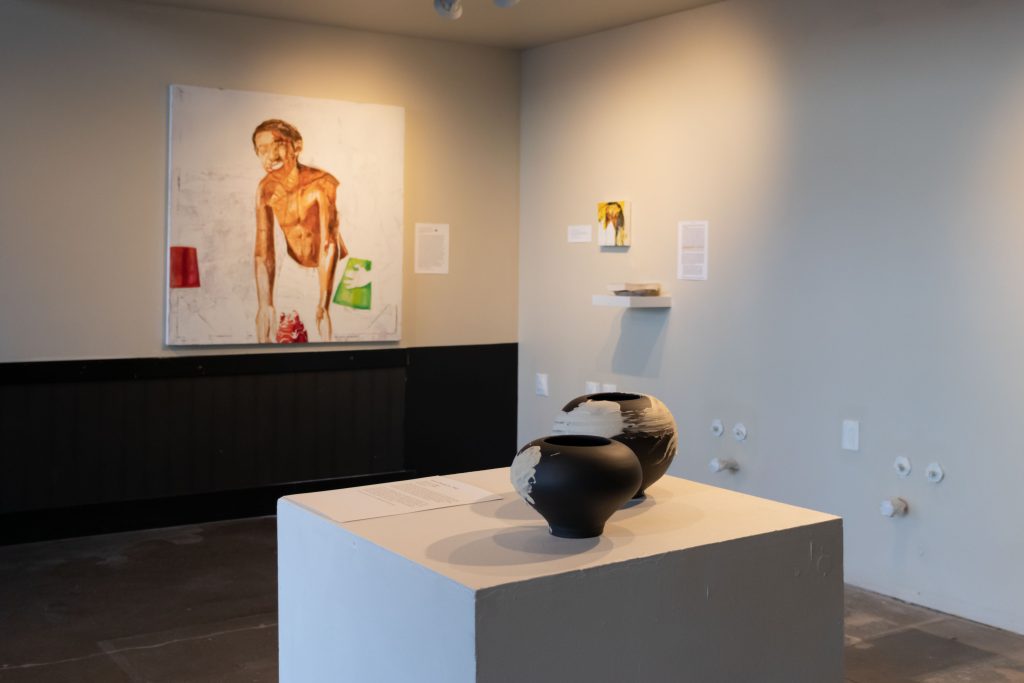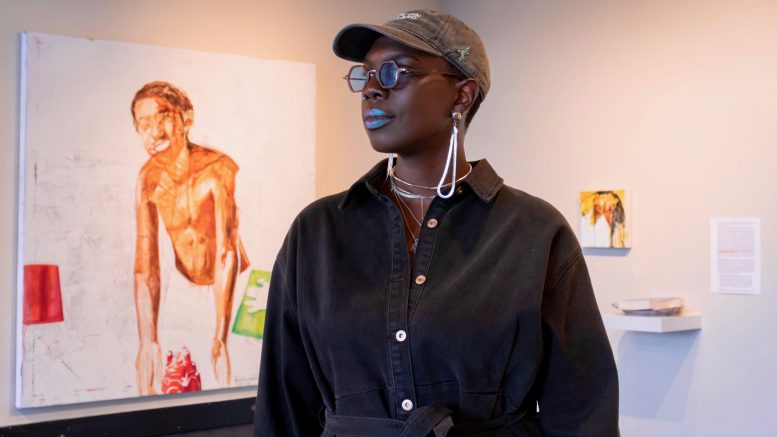After a year-and-a-half hiatus, FJM Gallery returns to a new Midtown location
By Melissa LuVisi
Art plays a crucial role in any city’s culture, attractability and vibrance. But in a post-pandemic era, shops, restaurants and small businesses are being crippled by the economic downturn. As fewer and fewer people return to the “office,” businesses in downtown Sacramento are struggling to stay afloat.
It’s creeping into Midtown as well: Where we once were seeing resilience in the streets of Sacramento, with people eating alfresco on every block, we are now seeing more and more restaurants and small businesses starting to close or move away.
But one space is making a triumphant return.
On Aug. 20, Faith J. Mickinnie’s eponymous gallery celebrated its reopening in its new location at 1020 16th St. McKinnie, an art entrepreneur and curator, invites artists and the community to reclaim their space in Sacramento’s narrative through an inaugural group show titled “When We See Us,” highlighting Black artists across mixed mediums. The gallery packed a full-house both for preview and opening nights, confirming the community’s appetite for more art spaces.
McKinnie’s vision for the gallery is a “Project Space for Curatorial Intervention.” Through her curatorial prowess, she aims to provide a space where artists, curators, viewers, and patrons can collaborate, learn, and engage in profound conversations. Through thought-provoking exhibitions and dynamic public programming, she hopes to invite other art entrepreneurs to step into the city’s empty spaces.
“With the closure of Kennedy Gallery, JAYJAY, Sparrow [Gallery], and [Be] Cool Club, the city is losing more art spaces than it’s gaining,” Mckinnie said. Galleries like hers aim to fill the gaps in Sacramento’s pandemic-hit arts sector.
As the Sacramento City Council and Gov. Gavin Newsom discuss bringing more affordable housing to the city, an emphasis has also been placed on creating spaces for the arts as well. California’s creative economy alone produced $194.1 billion in taxes this year, supporting over 5.1 million workers and generating $978.6 billion in total economic activity.
Art galleries and public programming help cultivate the creative economy. The city’s R Street Corridor revitalization project, now adorned with colorful murals and home to several art galleries, has increased foot traffic in the area, translating into increased spending and community engagement, an example of economic growth.
And the push for more arts is paying off.
This is the second gallery McKinnie has opened in the city in a space that would otherwise be overlooked. Her previous gallery (closed April 2022), was a pop-up in Midtown in the heart of the Ice Blocks. With the help of Sutter Capital Group who provided the space, McKinnie managed to breathe new life into a building that was set to be demolished.

Now, McKinnie has taken what was an abandoned Startbuck’s and turned it into a gallery. Her keen eye for elevating art, artists and their careers can be seen in the many opportunities that follow the artists she champions. Many of these artists have had museums acquire their work.One example is artist Jessica Wimbley’s video installation titled “The True Story of Edges,” a piece acquired by the Crocker Museum in 2023 through the Kingsley Art Club.
Many of the artists McKinnie has worked with in the past, such as painter Brandon Gastinell, have gone on to successfully pursue their careers in larger cities, a pattern that has emerged throughout Sacramento’s creative community. Local arts advocates say the city needs to ensure steps are taken to provide the same support systems artists are seeking in bigger metropolises like Los Angeles and San Francisco. Faith hopes that gallery’s such as hers will help keep artists local.
Along with more intentional measures to ensure the city preserves its artistic talent, Sacramento needs a diverse gallery network of its own, one where more spaces like FJM Gallery can continue to thrive. A push for affordable housing and affordable arts spaces is vital if the city is to attract and retain artists and creatives in an effort to revitalize the creative economy.
Wimbley, a mixed media artist and curator, said the city is positioned to capitalize on its empty spaces.
“Sacramento has the infrastructure, especially with it’s open spaces to grow a robust ecosystem
in which creatives can thrive,” Wimbley wrote in an email. “An important aspect of growing that ecosystem is having a variety of spaces that allow for the cultivation of community and artists. Art spaces are needed so that there is a scaffolding of entry and engagement with the arts.”
McKinnie said working with previous collaborators made her new gallery space possible.
“I received the space from Fulcrum Property and Heller Pacific owners Mark Friedman and Mike Heller, respectively. They asked what I could imagine in this old Starbucks retail location after working with me on the Arden Fair Mall ‘Black Creativity at the Heart of Sacramento’ [exhibit],” McKinnie said, adding that the location has been vacant since 2020.
McKinnie’s passion for the arts and their transformative power is evident, having reopened a much-needed space. But she can’t do it alone.
“Find your supporters and collaborators because you’ll need more than just access to the space. It takes thousands of dollars to get a space ready for public activation and engagement,” McKinnie said. “I’m so thankful for the Sacramento patrons that believe in my work and want to see creative use of the built environment.”
Editor’s note: This story has been updated to include the correct name of the exhibit, which is “When We See Us.”
This story is part of the Solving Sacramento journalism collaborative. Solving Sacramento is supported by funding from the James Irvine Foundation and Solutions Journalism Network. Our partners include California Groundbreakers, Capital Public Radio, Outword, Russian America Media, Sacramento Business Journal, Sacramento News & Review, Sacramento Observer and Univision 19. Take our reader survey.



Be the first to comment on "Sacramento arts community eagerly welcomes reopening of Faith J. McKinnie Gallery"